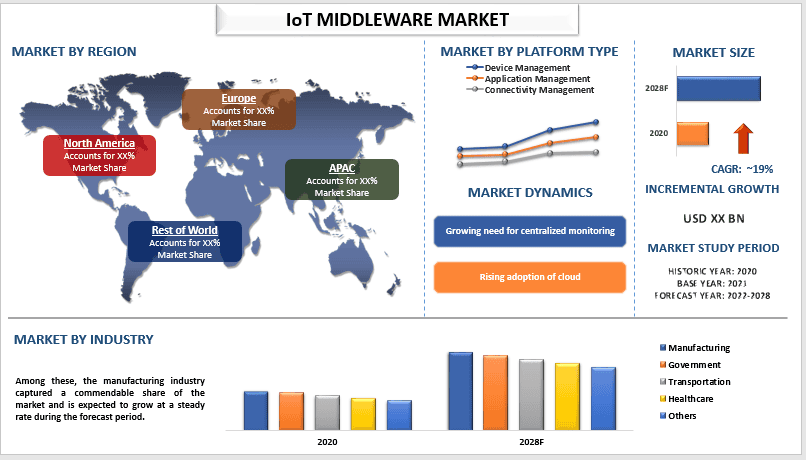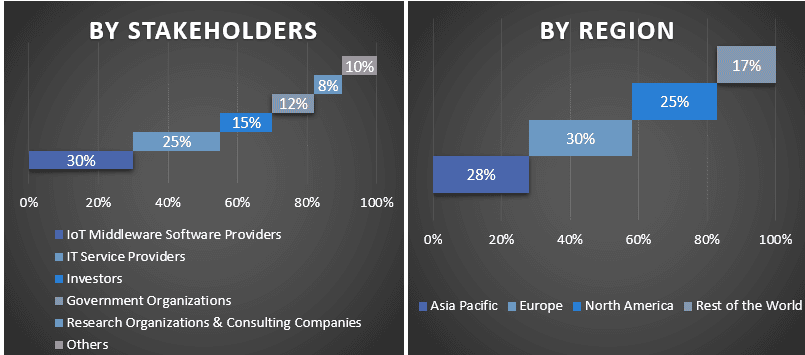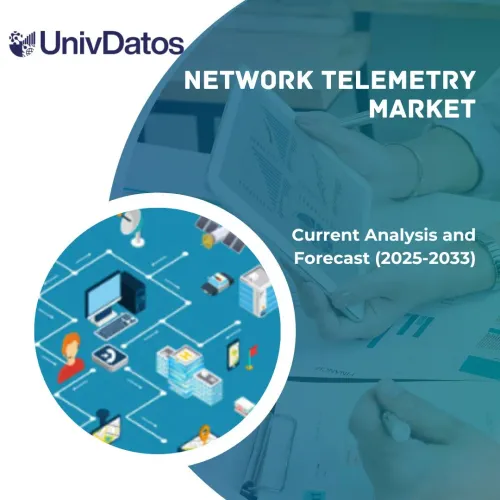- Home
- About Us
- Industry
- Services
- Reading
- Contact Us
IoT Middleware Market: Current Analysis and Forecast (2022-2028)
Emphasis on Platform Type (Device Management, Application Management, and Connectivity Management); Organization Size (Large Enterprises and SMEs); Industry (Manufacturing, Government, Transportation, Healthcare, and Others); and Region/Country

Global IoT Middleware Market is expected to grow at a significant rate of around 19% during the forecast period (2022-2028F). The global IoT middleware market is anticipated to witness an uptick with the increasing development of high-speed network technologies and the rising government investments and initiatives in projects like smart cities & automation are also fueling the market growth. IoT middleware is defined as software that acts as an interface between IoT components. It helps establish communication between IoT components. By establishing communication between IoT middleware and machine programs, machines, components, and hardware can be connected to IoT networks using IoT middleware. Furthermore, according to the GSM Association, IoT connections will reach almost 25 billion globally by 2025, up from 10.3 billion in 2018, which is further contributing to the growth of this market. Moreover, the absence of uniform IoT standards and concerns over data security and privacy are the major factors among others restraining the market growth.
Microsoft Corporation, International Business Machines Corporation, Amazon.com Inc., SAP SE, PTC Inc., Cisco Systems Inc., Google LLC, Hewlett Packard Enterprises, Robert Bosch GmbH, and Oracle Corporation are some of the key players in the market. Several M&As along with partnerships have been undertaken by these players to facilitate customers with hi-tech and innovative products/technologies.
Insights Presented in the Report
“Amongst organization size, large enterprises to witness robust CAGR during the forecast period”
Based on organization size, the market is classified into large enterprises and SMEs. Large enterprises are expected to witness influential growth. This is mainly because large enterprises are keen to utilize the advantages of IoT platforms to increase the scalability and efficiency of their businesses. The multiple benefits of IoT, such as reduced costs, increased agility, and scalability, increased revenue, and improved performance, have led small businesses to adopt IoT solutions. This will positively impact the growth of the IoT middleware market.
“Amongst industry, the manufacturing industry to hold a significant share in the market in 2020”
The market is segmented on the basis of manufacturing, government, transportation, healthcare, and others. The manufacturing industry caters significant share of the market and is expected to witness considerable growth in the forecasted period as well. Factors such as the increasing adoption of IoT in the manufacturing industry and the growing manufacturing sector all around the globe are accelerating the market outlook. For instance, according to the United Nations Industrial Development Organization (UNIDO), global manufacturing production increased by 9.4 percent in 2021, after the pandemic-related drop of 4.2 percent in 2020.
“Asia Pacific to hold a significant share in the market”
In 2020, APAC held a significant share of the global IoT middleware market. This is largely due to a growing awareness of business productivity enhancements complemented by well-designed IoT middleware platforms from local vendors. Further on, the presence of rapidly growing economies such as China and India, the adoption of IoT among various industries, and the rapidly growing manufacturing industry in the region are some of the most prominent factors driving the growth of the IoT middleware market in the region. For instance, in September 2021, the Indian government approved a PLI scheme worth USD 3.53 Bn for the auto industry and drone industry to boost India’s manufacturing capabilities.
Reasons to buy this report:
- The study includes market sizing and forecasting analysis validated by authenticated key industry experts.
- The report presents a quick review of overall industry performance at one glance.
- The report covers an in-depth analysis of prominent industry peers with a primary focus on key business financials, product portfolio, expansion strategies, and recent developments.
- Detailed examination of drivers, restraints, key trends, and opportunities prevailing in the industry.
- The study comprehensively covers the market across different segments.
- Deep dive regional level analysis of the industry.
Customization Options:
The global IoT middleware market can further be customized as per the requirement or any other market segment. Besides this, UMI understands that you may have your own business needs, hence feel free to connect with us to get a report that completely suits your requirements.
Table of Content
Research Methodology for the IoT Middleware Market Analysis (2022-2028)
Analyzing the historical market, estimating the current market, and forecasting the future market of the global IoT middleware market were the three major steps undertaken to create and analyze the adoption of IoT middleware in major regions globally. Exhaustive secondary research was conducted to collect the historical market numbers and estimate the current market size. Secondly, to validate these insights, numerous findings and assumptions were taken into consideration. Moreover, exhaustive primary interviews were also conducted, with industry experts across the value chain of the global IoT middleware market. Post assumption and validation of market numbers through primary interviews, we employed a top-down/bottom-up approach to forecasting the complete market size. Thereafter, market breakdown and data triangulation methods were adopted to estimate and analyze the market size of segments and sub-segments of the industry pertains to. Detailed methodology is explained below:
Seek More Details About Research Methodology
Analysis of Historical Market Size
Step 1: In-Depth Study of Secondary Sources:
Detail secondary study was conducted to obtain the historical market size of the IoT middleware market through company internal sources such as annual reports & financial statements, performance presentations, press releases, etc., and external sources including journals, news & articles, government publications, competitor publications, sector reports, third-party database, and other credible publications.
Step 2: Market Segmentation:
After obtaining the historical market size of the IoT middleware market, we conducted a detailed secondary analysis to gather historical market insights and share for different segments & sub-segments for major regions. Major segments are included in the report as platform type, organization size, and industry. Further country-level analyses were conducted to evaluate the overall adoption of testing models in that region.
Step 3: Factor Analysis:
After acquiring the historical market size of different segments and sub-segments, we conducted a detailed factor analysis to estimate the current market size of the IoT middleware market. Further, we conducted factor analysis using dependent and independent variables such as various platform type, organization size, and industry of IoT middleware. A thorough analysis was conducted for demand and supply-side scenarios considering top partnerships, mergers and acquisitions, business expansion, and product launches in the IoT middleware market sector across the globe.
Current Market Size Estimate & Forecast
Current Market Sizing: Based on actionable insights from the above 3 steps, we arrived at the current market size, key players in the global IoT middleware market, and market shares of the segments. All the required percentage shares split, and market breakdowns were determined using the above-mentioned secondary approach and were verified through primary interviews.
Estimation & Forecasting: For market estimation and forecast, weights were assigned to different factors including drivers & trends, restraints, and opportunities available for the stakeholders. After analyzing these factors, relevant forecasting techniques i.e., the top-down/bottom-up approach were applied to arrive at the market forecast for 2028 for different segments and sub-segments across the major markets globally. The research methodology adopted to estimate the market size encompasses:
- The industry’s market size, in terms of revenue (USD) and the adoption rate of the IoT middleware market across the major markets domestically
- All percentage shares, splits, and breakdowns of market segments and sub-segments
- Key players in the global IoT middleware market in terms of products offered. Also, the growth strategies adopted by these players to compete in the fast-growing market
Market Size and Share Validation
Primary Research: In-depth interviews were conducted with the Key Opinion Leaders (KOLs) including Top Level Executives (CXO/VPs, Sales Head, Marketing Head, Operational Head, Regional Head, Country Head, etc.) across major regions. Primary research findings were then summarized, and statistical analysis was performed to prove the stated hypothesis. Inputs from primary research were consolidated with secondary findings, hence turning information into actionable insights.
Split of Primary Participants in Different Regions

Market Engineering
The data triangulation technique was employed to complete the overall market estimation and to arrive at precise statistical numbers for each segment and sub-segment of the global IoT middleware market. data was split into several segments & sub-segments post studying various parameters and trends in the areas of platform type, organization size, and industry in the global IoT middleware market.
The main objective of the Global IoT Middleware Market Study
The current & future market trends of the global IoT middleware market were pinpointed in the study. Investors can gain strategic insights to base their discretion for investments on the qualitative and quantitative analysis performed in the study. Current and future market trends determined the overall attractiveness of the market at a regional level, providing a platform for the industrial participant to exploit the untapped market to benefit from a first-mover advantage. Other quantitative goals of the studies include:
- Analyze the current and forecast market size of the IoT middleware market in terms of value (USD). Also, analyze the current and forecast market size of different segments and sub-segments
- Segments in the study include areas of platform type, organization size, and industry
- Define and analysis of the regulatory framework for the IoT middleware industry
- Analyze the value chain involved with the presence of various intermediaries, along with analyzing customer and competitor behaviors of the industry
- Analyze the current and forecast market size of the IoT middleware market for the major region
- Major countries of regions studied in the report include Asia Pacific, Europe, North America, and the Rest of the World
- Company profiles of the IoT middleware market and the growth strategies adopted by the market players to sustain in the fast-growing market
- Deep dive regional level analysis of the industry
Related Reports
Customers who bought this item also bought










